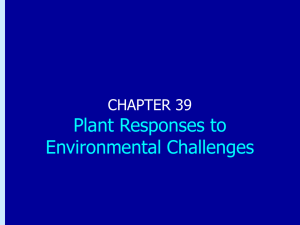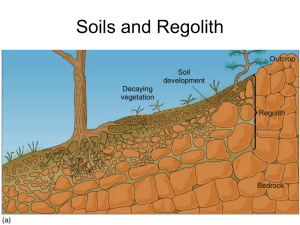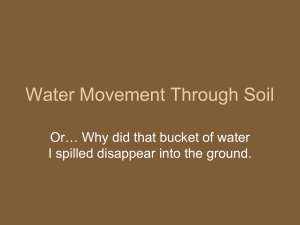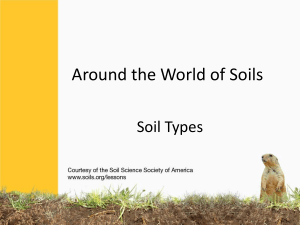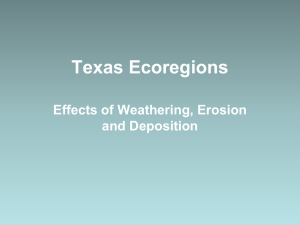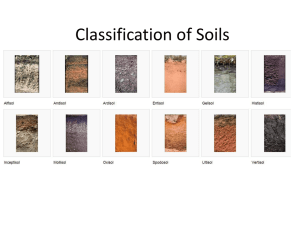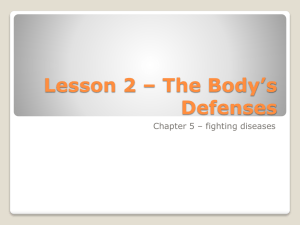Table of Contents
advertisement
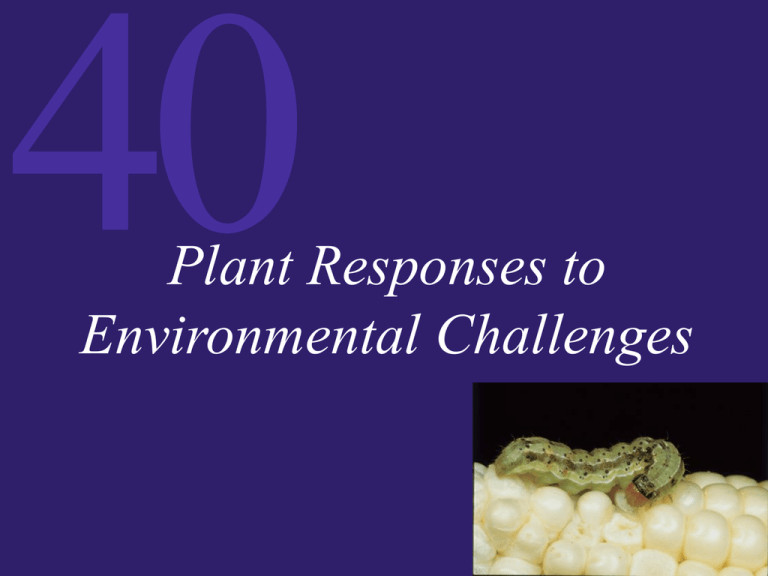
Plant Responses to Environmental Challenges 40 Plant–Pathogen Interactions • Pathogens have mechanisms for attacking plants, while plants have mechanical and chemical defenses to protect themselves. • Each set of mechanisms uses information from the other. • For example, pathogens may break down a plant’s cell walls, and the breakdown products signal the plant that it is under attack. 40 Plant–Pathogen Interactions • Plant tissues such as epidermis are protected from pathogens by cutin, suberin, or waxes. • Animals tend to repair damaged tissues; plants seal them off so the rest of the plant is not infected. 40 Plant–Pathogen Interactions • Chemical defenses include phytoalexins and pathogenesis-related proteins. • Infected plants cells produce phytoalexins within hours. • Phytoalexins destroy many species of fungi and bacteria nonspecifically. • Pathogenesis-related, or PR, proteins are enzymes that digest the cell walls of pathogens. • Other PR proteins may serve as alarm signals to cells that have not yet been attacked. Figure 40.1 Signaling between Plants and Pathogens 40 Plant–Pathogen Interactions • Many plants that are resistant to fungal, bacterial, or viral diseases use a strategy known as the hypersensitive response. • Cells around the site of infection rapidly die, preventing access to nutrients by the pathogen. • Phytoalexins and other chemicals are produced by the dying cells. The invading pathogen is contained within the dead tissue, called a necrotic lesion. • Salicylic acid is a defense molecule produced by willow and is the active ingredient of aspirin. Figure 40.2 The Aftermath of a Hypersensitive Response 40 Plants and Herbivores: Benefits and Losses • Grazing involves a predator eating part of a plant without killing it. • Grazing actually increases photosynthetic production in some plants. • Experimentally removing leaves from a plant has the same effect. The remaining leaves have increased production. 40 Plants and Herbivores: Benefits and Losses • Scarlet gilia is an example of a plant that benefits from grazing. • Grazing removes 95% of aboveground parts. • Each plant quickly grows four replacement stems for each one eaten. • Grazed plants produce three times as many fruits as ungrazed plants. • Some grazed trees and shrubs continue to grow until much later in the season than ungrazed plants. Figure 40.4 Overcompensation for Being Eaten 40 Plants and Herbivores: Benefits and Losses • Many plant defenses are activated by a series of signals. • Tomato leaf damage by a caterpillar’s chewing triggers a chain of events. • The signaling process involves two hormones. • The final step is the production of a protease inhibitor, which interferes with the insect’s ability to digest. • The hormones also act as attractants to insects that prey on the caterpillars. Figure 40.5 A Signaling Pathway for Synthesis of a Defensive Secondary Metabolite 40 Plants and Herbivores: Benefits and Losses • Other plants produce a toxin to ward off predators. • Arcelin is a protein produced by wild bean seeds that confers resistance to bean weevils. • Plants are now being genetically engineered to produce pesticides such as arcelin. • Many crop plants have been genetically engineered to produce the Bt toxin. 40 40 40 Water Extremes: Dry Soils and Saturated Soils • Some plants evade drought by carrying out their entire life cycle from seed to seed during a brief period of rainfall. 40 Water Extremes: Dry Soils and Saturated Soils • Other plants have structural adaptations to minimize water loss. These include heavy cuticles, a dense covering of epidermal hairs, and sunken stomata. the possession of fleshy, water-storing leaves. producing leaves only when water is available. having spines instead of leaves, and fleshy stems, as cacti do. leaves that hang vertically, avoiding the midday sun, as seen in Eucalyptus trees. Figure 40.8 Stomatal Crypts Figure 40.9 Opportune Leaf Production Leaves develop rapidly after rain. 40 Water Extremes: Dry Soils and Saturated Soils • These adaptations to dry environments minimize water loss, but also minimize the uptake of CO2. • In consequence, these plants usually grow more slowly but utilize water more efficiently than other plants do, fixing more grams of carbon by photosynthesis per gram of water lost to transpiration. 40 Water Extremes: Dry Soils and Saturated Soils • Mesquite trees can grow in arid environments using a taproot that grows to great depths. • Other plants have roots that die back during dry seasons but grow rapidly during rainy seasons. 40 40 Water Extremes: Dry Soils and Saturated Soils • Some plants live at the other extreme – water saturated environments where diffusion of oxygen to the roots is limited. • Some species have shallow root systems that carry on alcoholic fermentation. This results in slow growth. • Some roots have extensions that grow out of the water and up into the air. Figure 40.11 Coming Up for Air Mongroves Cypress Tree 40 Water Extremes: Dry Soils and Saturated Soils • Aquatic plants often have special tissue with large air spaces that stores oxygen produced by photosynthesis and permits its diffusion to other plant parts. • This also imparts buoyancy. 40 Habitats Laden with Heavy Metals • Some plants can survive on mine tailings, which have metal contaminants at levels toxic to most other plants. • Rather than excluding heavy metals, tolerant plants deal with them after taking them up. • Such tolerant plants may be useful for bioremediation, or the decontamination of an area by using living organisms. Wild pansy can grow in metalcontaminated soil. 40 Hot and Cold Environments • Temperatures that are too high or too low stress plants. • High temperatures destabilize membranes and denature proteins. • Low temperature causes membranes to lose fluidity and alters their permeability to solutions. • Freezing temperatures cause ice crystals to form, damaging cellular membranes. 40 Hot and Cold Environments • Plants produce heat shock proteins in response to high temperatures. • Some of these proteins are chaperonins that help other proteins maintain their structures and avoid denaturation. 40 Hot and Cold Environments • Low (just above freezing) temperatures can harm many plants. • Many plants can be modified to resist the effects of cold spells by producing more unsaturated fatty acids in the plant membranes. • Unsaturated fatty acids solidify at lower temperatures than saturated ones do, so the membranes retain their fluidity and function normally at cooler temperatures. • Some freezing-tolerant plants have antifreeze proteins that inhibit the growth of ice crystals.
